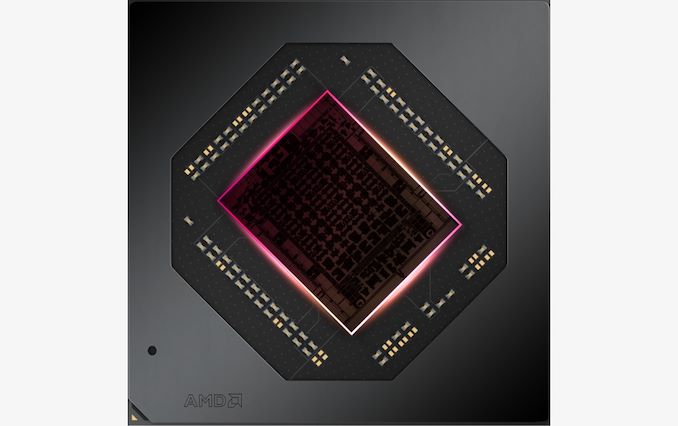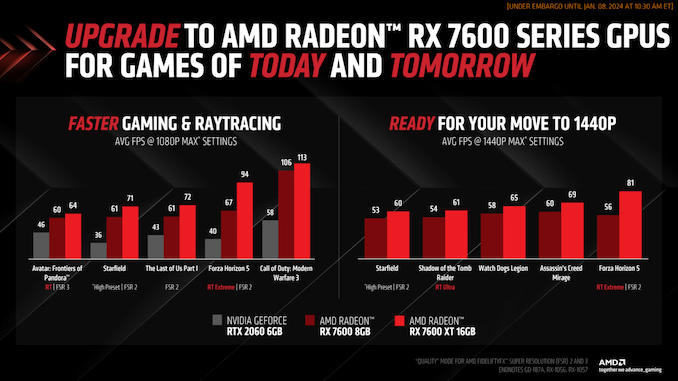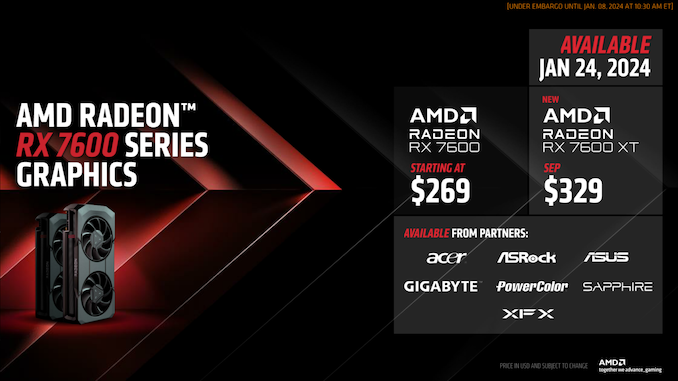AMD Adds Radeon RX 7600 XT To Product Stack, 1080p Gaming Card Gets 16GB For $329
by Ryan Smith on January 8, 2024 10:31 AM EST
Kicking things off for the GPU space at this year’s CES, AMD is at the show to announce that they’re bringing an additional Radeon RX 7000 series card to their lineup: the Radeon RX 7600XT. Intended as a premium version of their existing 1080p-focused RX 7600, the RX 7600 XT bumps things up with roughly 10% higher clockspeeds, as well as a doubling the total amount of VRAM to 16GB of GDDR6. The upgraded Radeon card will hit retail shelves on January 24th for a similarly premium price of $329.
The start of 2024 finds AMD doing some minor shuffling of their product stack both to cover the latest trends in gaming and AI, as well as to cover perceived gaps in the company’s product lineup. While AMD is just in the middle of their product cycle with their actual GPUs – the mid-tier Navi 32 GPU only launched back in August – the company currently has a decently large gap between the $270 Radeon RX 7600 and $450 RX 7700 XT, which they are opting to fill now with the RX 7600 XT. At the same time, video cards with 8GB of VRAM are becoming increasingly unappealing to buyers, especially the VRAM-hungry AI crowd, so this gives AMD the chance to offer a 16GB version of their basic gaming video card.
| AMD Radeon RX 7000 Series Product Stack | |||
| Current Price | |||
| Radeon RX 7900 XTX | $979 | ||
| Radeon RX 7900 XT | $799 | ||
| Radeon RX 7800 XT | $510 | ||
| Radeon RX 7700 XT | $439 | ||
| Radeon RX 7600 XT | $329 | ||
| Radeon RX 7600 | $269 | ||
The AMD Radeon product stack going into 2024 looks like the above, with the RX 7600 XT joining the rest of the Radeon RX 7000 lineup. AMD is not shuffling any other Radeon cards at this time; so there are no price cuts at either end of the spectrum, or other card introductions to talk about.
| AMD Radeon RX 7000 Series Specification Comparison | ||||||
| AMD Radeon RX 7700 XT | AMD Radeon RX 7600 XT | AMD Radeon RX 7600 | AMD Radeon RX 6600 XT | |||
| ALUs | 6912 (54 CUs) |
4096 (32 CUs) |
4096 (32 CUs) |
2048 (32 CUs) |
||
| ROPs | 96 | 64 | 64 | 64 | ||
| Game Clock | 2171MHz | 2470MHz | 2250MHz | 2359MHz | ||
| Boost Clock | 2544MHz | 2760MHz | 2655MHz | 2589MHz | ||
| Throughput (FP32) | 30 TFLOPS | 20.2 TFLOPS | 18.4 TFLOPS | 9.7 TFLOPS | ||
| Memory Clock | 18 Gbps GDDR6 | 18 Gbps GDDR6 | 18 Gbps GDDR6 | 16 Gbps GDDR6 | ||
| Memory Bus Width | 192-bit | 128-bit | 128-bit | 128-bit | ||
| Memory Bandwidth | 432GB/sec | 288GB/sec | 288GB/sec | 256GB/sec | ||
| VRAM | 12GB | 16GB | 8GB | 8GB | ||
| Infinity Cache | 48MB | 32MB | 32MB | 32MB | ||
| Total Board Power | 245W | 190W | 165W | 160W | ||
| Manufacturing Process | GCD: TSMC 5nm MCD: TSMC 6nm |
TSMC 6nm | TSMC 6nm | TSMC 7nm | ||
| Transistor Count | GCD: 19.9B MCD: 2B x4 |
13.3B | 13.3B | 11.06B | ||
| Architecture | RDNA3 | RDNA3 | RDNA3 | RDNA2 | ||
| GPU | Navi 32 | Navi 33 | Navi 33 | Navi 23 | ||
| Launch Date | 09/06/2023 | 01/24/2024 | 05/25/2023 | 08/11/2021 | ||
| Launch Price | $449 | $329 | $269 | $379 | ||
Under the hood, the Radeon RX 7600 XT is being driven by the same Navi 33 GPU as its non-XT counterpart – a chip which also happened to be introduced at last year’s CES. The odd man out of the Navi 3x GPU lineup, this RDNA3 part is a monolithic die that’s produced on TSMC’s 6nm process – unlike the more advanced 5nm/6nm chiplet-based Navi 32 and Navi 31 GPUs. The chip brings all of the core RDNA3 features, including the new compute structure, ray tracing improvements, and AV1 encoding support, but it’s clearly intended to be a relatively cheap chip to produce, especially going into 2024.
AMD’s first Navi 33-based card, the Radeon RX 7600, was already using a fully-enabled Navi 33 die, with all 32 CUs and 64 ROPs available. As a result, AMD’s newest XT card breaks from tradition a bit by not offering any further hardware blocks over its non-XT counterpart. Instead, all of the performance advantage for the new card is driven by a combination of the larger 16GB of VRAM, along with clockspeed and power limit changes.
Starting with the GPU itself, RX 7600 XT bumps up the rated game clock to 2470MHz, a roughly 10% GPU clockspeed increase over the 2250MHz RX 7600. The increase in the peak (boost) clocks is less dramatic, increasing by 105MHz to 2760MHz (4%). Since this is entirely a clockspeed-driven performance improvement, everything about the GPU, from pixel throughput to ray tracing to texturing, should be around 10% faster than the RX 7600.
The wider jump in the rated game clock comes thanks to the card’s higher total board power (TBP) limit, which for reference-level cards is 190W. This is 25W higher than the RX 7600, giving AMD’s power budget the room to absorb the additional DRAM, while also leaving some for raising the clockspeeds. In practice, this means it’s likely that AMD’s energy efficiency is going to drop here (15% more power for 10% higher clockspeeds), but AMD hasn’t been pushing energy efficiency very hard this generation to begin with – nor is a 6nm part in a great place to start with.
Rather than the GPU, the biggest change here is the VRAM capacity. AMD is giving the RX 7600 XT 16GB of GDDR6, twice as much VRAM as the 8GB RX 7600. The actual memory clockspeed remains unchanged at 18Gbps, for a total of 288GB/second of memory bandwidth. But for titles that were previously performance (or quality) capped by 8GB of VRAM, this will give them ample room to grow for better performance. AMD has not disclosed the specific DRAM topology used here, but as 32Gbit GDDR6 chips are readily available, we’re almost certainly looking at 4x32Gbit rather than a clamshell (8x16Gbit) setup.
Otherwise, because the GPU itself is unchanged, the same 32MB infinity cache as on the RX 7600 sits between the rest of the GPU and the larger VRAM pool.
There is one final technical improvement that AMD is making over the RX 7600 that should also be noted here: DisplayPort 2.1 support is no longer optional; it is now mandatory. On the RX 7600, board partners were allowed to ship designs that were only DisplayPort 1.4 (HBR3) compliant, presumably as a cost-cutting measure for the budget video card. However, as the RX 7600 XT is designed to be a more premium card, that option has gone away and board partners must support the GPU’s full capabilities.
With that said, however, AMD has not clarified which DisplayPort 2.1 data rate(s) the card will support. The other consumer Radeon cards have all supported UHBR 13.5 – DP 2.1’s mid-tier data rate – however the Radeon Pro W7600, another Navi 33 based card with DP 2.1 support, only offered support for UHBR 10 data rates. So given that precedent and AMD’s omission of additional information, it may very well be that the RX 7600 XT is capped at the lower UHBR 10 data rates.
Production Positioning, Partner Cards, & Availability
As noted towards the start of this article, the Radeon RX 7600 XT exists to plug a hole in AMD’s product lineup, while also giving them something a bit more future-proof going into 2024 as 8GB cards become less tenable.
Besides new gaming system builds – which always need a video card – AMD’s marketing team will be pitching the card as an upgrade over older 1080p video cards a couple of generations old, particular the original GeForce RTX 2060. A 6GB card to begin with and turning 5 years old this month, AMD believes there’s a market there with gamers whose existing cards aren’t keeping up at 1080p with the latest games.
I’m not huge on vendor-produced benchmarks, but as the RX 7600 XT isn’t due out for a couple more weeks, this is what we have for now. Given that AMD is selling a high VRAM capacity card, I expect these games and setting all make heavy use of VRAM. And in the case of Forza Horizon 5, AMD isn’t afraid to throw their own 8GB RX 7600 under the bus as well to prove a point.
In practice, I don’t see any reason for the RX 7600 XT to significantly change the performance calculus among the Radeon RX 7600 series and GeForce RTX 4600 series, but this gives AMD another option to pitch, especially against the 8GB RTX 4060.
And in a sign of things to come, AMD is now dedicating a marketing slide about their ostensibly gaming-focused budget video card to AI performance. With large language models (LLMs) living up to the name with their memory requirements, cheap cards with lots of VRAM have been popular options for small-scale AI inference, so AMD is looking to capitalize on that, especially as Navi 33 has been out long enough that it should have good support under ROCm on Linux.
As for the hardware itself, this will be a pure AIB launch. AMD will not be selling an reference card (not to consumers, at least), and instead the retail market will be supplied entirely by AIB designs supplied by AMD’s partners. All of AMD’s partners have been producing Navi 33 cards for some time now for their RX 7600 designs, so most of them will be able to hit the ground running on RX 7600 XT without making massive changes. Of the photos sent in advance by AMD, all of the RX 7600 XT cards depicted are a mix of dual-fan and triple-fan designs, similar to the spread we see today with RX 7600 cards on the market.
This also means that we should expect a similar spread of factory overclocked designs as well, with higher clockspeeds and TBPs. RX 7600 XT is AMD’s go-for-broke Navi 33 desktop card, and there’s still a good $100 gap between it and the RX 7700 XT that board partners will look to fill with their factory overclocked wares.
The head-to-head competition for the RX 7600 XT will be NVIDIA’s GeForce GTX 4060 series cards, as well as Intel’s Arc A770. Unlike the RX 7600, AMD doesn’t have a price spoiler advantage here, so they need the RX 7600 to be flat-out better than the RTX 4060 – and enough so to overcome NVIDIA’s market share momentum these days. With the 16GB RTX 4060 Ti costing around $450, AMD has the advantage there when it comes to 16GB cards. But then again, Intel will sell you a 16GB Arc A770 for $300, so AMD doesn’t even get to claim to have the cheapest 16GB card.
Wrapping things up, the new Radeon RX 7600 XT will be hitting retail and e-tail shelves on January 24th. Cards will start at $329.


























10 Comments
View All Comments
meacupla - Monday, January 8, 2024 - link
I am hoping this card kills the 4060/Ti/16GB price tags.I also hope this comes in a low profile version.
HarryVoyager - Monday, January 8, 2024 - link
I'll be honest, I don't understand AMD's marketing plan here. They've got the margins to put that at $299 and the 7900 XT at $750 and the 7900 XTX at $900, and just deflate nVidia's entire super launch before it starts.Do they just not have the capacity? Do they think the market isn't there? Or do they think they're doing a 'big brain' move by keeping their list prices high so the day 1 reviews are "meh, too expensive" and letting the street price drift down so people think they're getting a deal?
techjunkie123 - Monday, January 8, 2024 - link
Typical big brain AMD marketing move..... let's save the price drops for 1 weeks or 1 month after release so the reviews are negative.....then rely on people knowing updated information before purchasing. LMAO.Samus - Tuesday, January 9, 2024 - link
As useless as additional memory is for 1080p gaming (although according to their benchmarks above there is an astonishing increase in speed I can only comprehend being more related to the higher clock speed than the memory headroom) the fact is "gigabytes" sell to the uninformed customer.meacupla - Tuesday, January 9, 2024 - link
4060Ti 16GB had drastically better 1% lows in games like TLOU and RE4, compared to the 4060Ti 8GB.Now, do these cards need 16GB? No, but 8GB is not enough either.
They need 12GB at most, but no one has made GDDR6 3GB chips either.
nandnandnand - Wednesday, January 10, 2024 - link
Sometimes the prices go down and then back up, like 7900 XTX and others have this gen. So they don't want to set the MSRP too low.meacupla - Tuesday, January 9, 2024 - link
At $329 Intel has the A770, which is already slower than the 7600.With 16GB criteria, we have the 4060Ti 16. It is priced at $450.
But at $450, there is the RX7700XT 12GB, and it is faster than the 4060Ti 16GB at everything.
So with the 7600XT 16GB, we get something that is faster than the A770, but severely undercuts the 4060/Ti/16GB.
But yes, we all want the 4060Ti 16GB to be at $250.
edzieba - Tuesday, January 9, 2024 - link
"I'll be honest, I don't understand AMD's marketing plan here. "It's pretty simple: 16GB is a big number on the box, so as long as that number is bigger than the number on the box of price comparative cards, it will sell better.
Actual performance is mostly irrelevant to that segment of the market, they have already decided that More RAM = More Better, so you can just give them more RAM without needing to worry that performance is bottlenecked elsewhere (e.g. memory bandwidth, core performance, etc).
mczak - Monday, January 8, 2024 - link
"AMD has not disclosed the specific DRAM topology used here, but as 32Gbit GDDR6 chips are readily available, we’re almost certainly looking at 4x32Gbit rather than a clamshell (8x16Gbit) setup."I'm almost 100% certain this is just wrong. None of the "usual 3" gddr6 manufacturers have 32gb ggdr6 chips in their catalogs, nor did they even announce any (unless you're counting samsung's gddr6w). Hence this will be a clamshell design (non-availability of 32gb gddr6 chips is supposedly the reason why those cheaper graphic cards didn't release with higher vram capacity options earlier in the first place, since clamshell designs require a different pcb).
brucethemoose - Tuesday, January 9, 2024 - link
> non-availability of 32gb gddr6 chips is supposedly the reason why those cheaper graphic cards didn't release with higher vram capacity options earlier in the first place, since clamshell designs require a different pcbI thought it was product segmentation to protect the W series?
I would have bought a 40GB-48GB 7900 in a heartbeat, just not for $4.5K like the W7900. In fact, you'd see a lot more AMD GenAI support if they sold such an SKU.